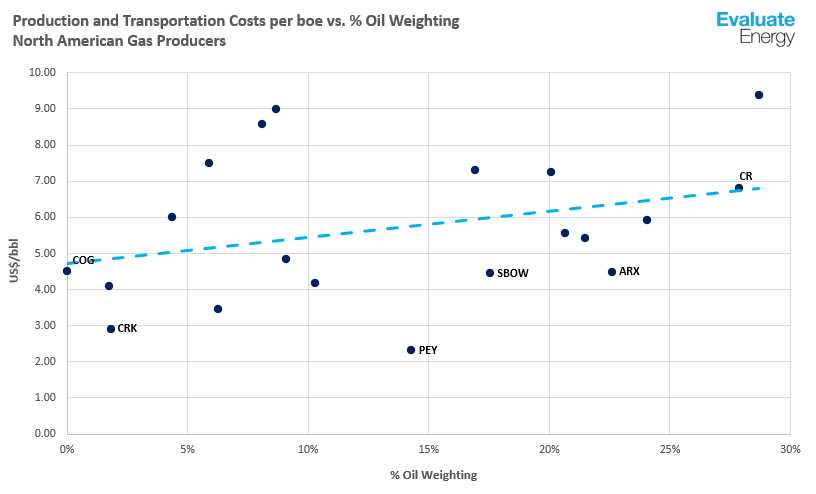Insights
Q2 2020 – Lowest Cost Natural Gas Producers in North America

Canada’s Peyto Exploration and Development and ARC Resources rank among North America’s lowest-cost natural gas producers, according to the latest data from Evaluate Energy.
This analysis was conducted using Q2 2020 operating and transportation expenses per barrel (“production costs”) for some of the most heavily gas-weighted, publicly listed producers in Canada and the United States.
Click here for a free download of production cost data for all 20 companies in this analysis
In summary:
- All 20 companies produced over 10,000 boe/d in Q2 2020.
- The companies were selected for this natural gas cost analysis because their portfolios were among the more heavily gas-weighted than other companies producing at least 10,000 boe/d in Q2 2020. This avoids oil and liquids production skewing the analysis.
- The companies only produced in North America and oilsands producers were excluded.
- Production tax costs in the U.S. are excluded, as are royalty expenses in Canada.
Low cost production is just one key indicator that investors and industry observers will be looking for to identify healthy gas producing companies in the current climate. For more on the higher cost producers in the group, click here.
The most recent production cost data and key conclusions are presented below.

Source: Evaluate Energy
Overall portfolios must be considered
The trend line on the chart, calculated using the production costs of all companies in the group, shows that as oil weighting increases, so does the average cost per barrel of oil equivalent to produce for each company.
Therefore, if one company was producing at $2/boe higher than another this might not make it a “higher cost operator”. It may be because oil makes up a higher proportion of its portfolio.
To illustrate this we examined costs reported both by Cabot Oil & Gas (COG) in the U.S. Appalachian Basin and Crew Energy (CR), a Montney producer in Canada.
- On the face of it, it appears that Crew is a much higher cost operator at $6.82/boe compared to Cabot’s $4.51/boe.
- In fact, both companies sit almost exactly on the trend line, meaning that Crew’s higher cost per boe can be attributed almost entirely to the higher percentage of liquids in its portfolio.
Examining costs per boe alone can be misleading. When deciding if a company is a producer with high production costs, these metrics must be considered relative to the company’s overall portfolio.
Based on the combined metrics of costs per boe and each company’s oil weighting, we have identified the lowest cost producers based on Q2 2020 data.
Lowest cost natural gas producers
At just $2.32/boe, Alberta Deep Basin producer Peyto Exploration & Development (PEY) recorded the lowest production costs. They were also the lowest cost relative to the trend line of all 20 producers. The trend line anticipates production costs between $5.50-$6.00/boe for a company like Peyto with a portfolio of 14% liquids.
Comstock Resources (CRK) was the lowest cost U.S.-based producer of the group at $2.91/boe. Only two companies (Cabot and Goodrich Petroleum) produced a lower level of liquids relative to their portfolios. While Comstock hovers around $1.50/boe below the trend line, the majority of its low costs can be attributed to the high natural gas weighting of its Texas and Louisiana production base.
After Peyto, the next furthest from the trend line in terms of low costs is Canadian producer ARC Resources (ARX). Its Q2 2020 production costs in the Montney and Pembina Cardium of $4.50/boe are around $2/boe below the expected costs for a portfolio comprised of 23% liquids.
Of the remaining low-cost U.S. producers, Eagle Ford-focused Silverbow Resources recorded production costs of $4.45/boe in Q2 2020, a comparable distance of around $1.50/boe from the trend line to Comstock Resources.
Click here for a free download of production cost data for all 20 companies in this analysis
Evaluate Energy data allows a comprehensive review of liquidity and company health. Alongside these production cost metrics, data includes debt and interest measures, credit availability figures, hedging portfolios and earnings guidance.
